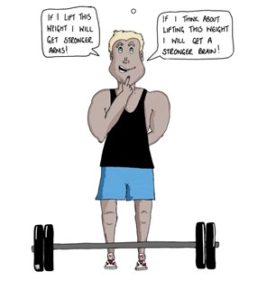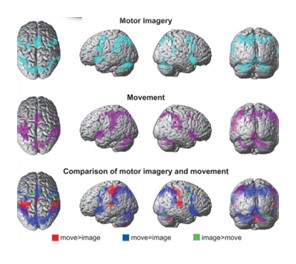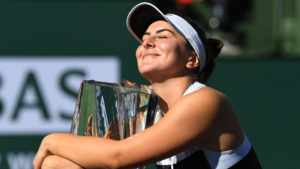Luc our Strength and Conditioning coach has produced this blog which provides a better understanding of visualisation, a tool players can use to continue training their mental and physical skills whilst off court. Some practical tips are provided about their application.
“Imagination is more important than knowledge” Albert Einstein
Let’s start with a short story!
Sasha, a 6 year old boy, wakes up on Christmas day, filled with excitement about the presents waiting for him under the tree. He jumps out of bed, gets dressed and runs down the stairs to find his parents waiting for him in the living room. They hand him three presents. He decides to open the biggest one first… it’s a bike! To his parents’ surprise, Sasha hops on the bike and rides around the living room, despite never having ridden a bike before. His parents are shocked at what they’re seeing. Upon their curious looks, Sasha says, “I have been dreaming so much and I have been imagining so much that… it’s easy!”
This is the power of visualisation!
Visualisation, you say?
We can talk about motor imagery, visualisation, imagined practice… all these terms are similar and refer to one of the most remarkable human mental capacities: the process by which one can imagine and simulate the sensations of an action without engaging in its physical execution.
Have you ever imagined yourself flying? Or having incredible superpowers? This is the best proof that we all visualise frequently throughout each day, although most of the time subconsciously.
We must not confuse motor imagery with mindfulness. Mindfulness is a different kind of mental training, referring to an open-minded and non-judgmental awareness of oneself and one’s environment. In tennis terms, this can mean accepting the frustration we feel when we make an error or double fault at a key point in the game. This is another very interesting topic, but we’ll save it for another time.
The possibility to transform our lives with visualisation is a powerful ability that we all have as human beings. We all have the capacity to create our reality by thinking, doing and visualising. Our thoughts and emotions have an undeniable impact on our reality, regardless of whether or not we are aware of this process.
You don’t need to be a Tibetan monk or have extraordinary skills to use and master this innate ability. You just need to take time to visualise and create your new reality.
You have everything you need, it’s all right there in your head.
What’s happening in our brain, exactly?
The power of imagined practice is huge due to its capacity to reproduce the neurological routes that would occur if we performed the situation in reality.
Each time we move, our central nervous system (CNS) creates an electrical message which travels along our spine to our muscles, making them contract. Our brain is a wonderful engine and is incredibly intelligent, with the ability to differentiate between real and imagined movement.

However, the preparation and control networks in the brain are always turned on, thus both imagined and executed movement will result in a similar brain activity.
This article is centred around tennis, but take a second to think about all the areas in our life that motor imagery can impact: skill development, performance enhancement, CNS injury recovery… The possibilities are huge.
Figure 1. The comparison of movement-related and imagery-related activities.
Bianca Andreescu and the power of visualisation
Bianca Andreescu is a perfect example of the power and benefit of visualisation. Andreescu is a 19-year-old Canadian tennis player who won the 2019 US Open Women’s Singles, beating Serena Williams in the final. Giving an incredible performance throughout the tournament, she displayed a level of calmness and courage that is very impressive for her age.
 The talented teen makes use of a very important tool: visualisation. According to her, it’s no secret that this is what has made all the difference in her recent victories. She has been using these mental techniques since she was thirteen and has said that it helps her focus and be at one with her mind, which in turn allows her to control her whole body. What may shock you is that she only spends fifteen minutes a day on this, which is such a short amount of time for something so beneficial.
The talented teen makes use of a very important tool: visualisation. According to her, it’s no secret that this is what has made all the difference in her recent victories. She has been using these mental techniques since she was thirteen and has said that it helps her focus and be at one with her mind, which in turn allows her to control her whole body. What may shock you is that she only spends fifteen minutes a day on this, which is such a short amount of time for something so beneficial.
“I put myself in situations that I think can happen in a match, basically.”
“I think your biggest weapon is to be as prepared as you can. I really think that working your mind is important because at this level everyone knows how to play tennis.” Bianca Andreescu
How can I start integrating visualisation into my day?
As mentioned above, visualisation is a powerful tool and to master it provides the opportunity to develop many areas: strength training, improving technical or tactical skills, increasing motor performance in specific tasks, reducing anxiety… The possibilities are huge! But it requires a certain amount of rigor.
Using our imagination is a good start, but it’s not enough to train our specific neural connections.
Here are our 5 tips to help you integrate this work into your daily routine:-
1. Don’t be scared. We all visualise everyday.
I’m sure you’ve spent minutes, hours, maybe even a whole night anxiously imagining your upcoming match and the many scenarios possible. This is visualisation and we all do this, whether it’s for a tennis match, an exam, an interview.
Now, the key here is to focus on directing this visualisation towards meeting your goals and objectives, rather than involuntarily allowing the anxious thoughts to negatively affect your state of mind and thus your performance. “The more you practise, the more effective this will be”.
The new reality you create in your mind must be as close as possible to a real-life scenario. “Respect the duration and the speed!”
2. Start with easy, non-specific visualisation drills.
One of the most important aspects of this process is experiencing emotions, as this will provide more credibility to your brain. You have to be able to see, hear or feel to facilitate the learning process.
Situations such as imagining yourself cooking or doing another activity which awakens your senses have to be your first step. Looking back on a situation you’ve already experienced is the easiest way to recreate as many details as possible and increase the effectiveness of this work.
Once you’re able to successfully create complex emotions, you can start more specific work.
3. Make sure you’re in a good mood!
Due to the importance of our emotions, make sure you’re doing this work whilst in a positive mood, feeling confident and content.
This will facilitate the connection between the situation you’re visualising/working on and other memories of confidence and achievement.
4. You don’t need to be lying down!
Whilst visualising, try to replicate the energetic state of the situation you want to improve. In other words, don’t relax on the sofa if you’re visualising yourself running or lifting heavy weights!
To influence your new reality, try implementing follow-through movement. If you’re picturing yourself playing shots, use a tennis racket to replicate the movements. If you’re imagining squatting in the gym, use a stick in the same way you’d use a barbell.
This requires some technical knowledge about your activity and body, but give it a try and figure out the most effective method that works for you.
5. How long should I practise for?
Now that your brain is working as hard as it would be on-court, remember to allow your brain to recover between repetitions, and make sure not to train for too long. 10 to 15 minutes of work per day is already a good start.
If you get tired, you will lose your focus and this will hinder the effectiveness of visualisation.
You should now have a better understanding of why and how you can use visualisation to improve your tennis.
Remember Einstein’s words, “If you want different results, do not do the same things”. Expanding your toolbox of resources will make you a better player and you’re guaranteed to notice the difference.
You might not want to go up against Serena Williams, but no matter the objective, visualisation is the best gift you can give yourself to create the life you want the way you want it.
Good luck!
Luc Bardeau
Strength & Conditioning Coach, SotoTennis Academy
Do you want to develop your Visualisation skills? Register for our Mindfulness Mastery course for Visualisation and Mindfulness exercises and activities designed for tennis players and coaches.
References
Aherne, C., Moran, A.P. & Lonsdale, C., 2011. Mindfulness and flow in sport: an initial investigation. The Sport Psychologist, 25(1), pp.177- 189.
Guillot, A., 2019. L’imagerie mentale pour (re)muscler le cerveau et le corps [Online]. Available from: https://youtu.be/32dape5tzxA [Accessed 9 April 2020].
Guillot, A., Desliens, S., Rouyer, C. & Rogowski, I., 2013. Motor Imagery and Tennis Serve Performance: the external focus efficacy. J Sports Sci Med, 12(2), pp.332-338.
Hanakawa, T., Dimyan, M.A. & Hallett, M. (2008). Motor planning, imagery, and execution in the distributed motor network: a time-course study with functional MRI. Cerebral Cortex, 18(12), pp. 2775‑88.
Jiménez, L.J., 2017. Creativity on court I: felt visualization. ITF Coaching and Sport Science Review, 73(25), pp.27-29.